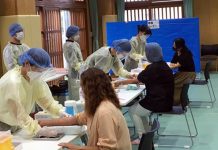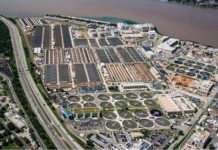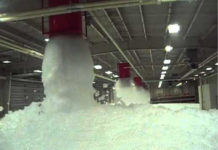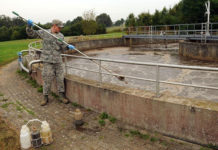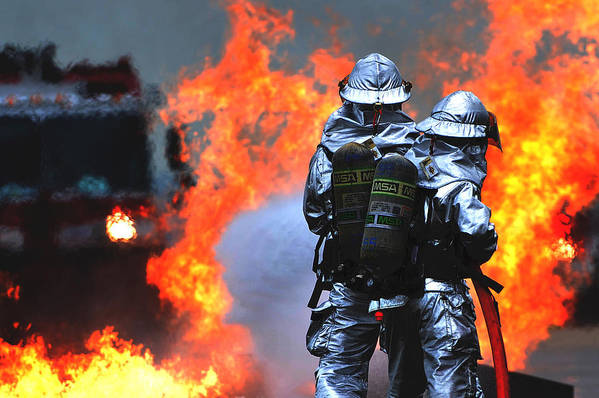
Drinking Water, Rivers, Fish, Crabs, Breast Milk, Babies and Teenagers Are Poisoned
United States Forces Korea would like the South Korean public to believe that the threat to public health posed by its use of per- and poly fluoroalkyl substances, (PFAS) since the 1970s is not much of a problem anymore. The military command is making a compelling case that drinking water on bases is no longer a threat and that the toxic firefighting foams, which they admit caused the contamination, will be completely phased out next year.
The drinking water is still a threat, according to test results made public, although there has been a tremendous reduction in PFAS concentrations. Also, the Pentagon has stopped using the foam in routine training exercises, but it is still present in airplane hangar sprinklers, Navy ships, and submarines.
Sadly, the military also uses PFAS in engine cleaning, wire coating, chrome plating, and other applications. The deadly toxins are often allowed to drain into the soil or the closest river, or they are sent to wastewater treatment plants where they flow into rivers without being treated. Consequently, marine life is poisoned, and so are people.
The sludge produced by the military’s wastewater treatment plants contains high levels of PFAS.
It is applied to agricultural fields, a process that contaminates crops, soil, groundwater, surface water, and the fish—again. The sea becomes a chemical toilet.
PFAS takes forever to break down. We cannot burn it and we cannot bury it. We must stop making it and using it.
Based on the known levels of PFAS contamination at U.S. military bases worldwide, we can expect high concentrations of carcinogens in the food, water, soil, subsoil, surface water, sediment, groundwater, surface water, air and dust within miles of each U.S. military installation in South Korea.
We shall examine the drinking water data provided by the U.S. military in South Korea, followed by a discussion of political impediments to potential remediation. We shall look at PFAS contamination in other environmental media and, finally, we shall analyze the devastating impact PFAS has on the health of the South Korean population.
It is difficult to determine the share of PFAS contamination in the environment caused by the U.S. military on the one hand and South Korean industry on the other. It is fair to say, however, that regions surrounding U.S. military installations are likely to be most impacted by the U.S. military’s past and present use of these chemicals.

PFAS in Drinking Water on U.S. Bases
The DOD only provides results on two compounds—PFOA and PFOS—and they do not tell us the concentrations of each. Commercial labs often provide results for 55 compounds. The interim Lifetime Health Advisory, prepared by the U.S. Environmental Protection Agency (EPA), is 0.04 parts per trillion (ppt) for PFOS and 0.004 ppt for PFOA.
South Korea regulates the total of PFOS and PFOA at 70 ppt so the U.S. military command is pleased that its results are under this threshold.
Fleet Activities Chinhae
PFOA/PFOA – 10.8 ppt (2022)
Fleet Activities Busan
PFOA/PFOS – 18.0 ppt (2022)
Camp Carroll
PFOA/PFOS – 1,066 ppt (March 2018)
PFOA/PFOS – 2.9 ppt (February 2023)
Camp Walker
PFOA/PFOS – 789 ppt (March 2018)
PFOA/PFOS – No detection (February 2023)
Camp Red Cloud
PFOA/PFOS – 466 ppt (March 2018).
PFOA/PFOS – 4.4 ppt (February 2023)
Camp Stanley
PFOA/PFOS – 1,061 ppt (March 2018)
PFOS/PFOA – 18.3 ppt (December 2021)
USAG Humphreys
PFOA/PFOS – 23.8 ppt (December 2022)
USAG Yongsan
PFOA/PFOS – 31.6 ppt (February 2023)
USAG Casey (May 2021)
No records
Kunsan Air Base
PFOA/PFOS – 85 ppt (March 2018)
PFOA .325 ppt; PFOS – .69 (June 2022)
Osan Air Base
PFOA/PFOS – No Detection (2020)
Suwon Air Base
PFOA/PFOS – No Detection (2019)
Camp Mujuk (USMC)
PFOA – 3.8; PFOS – No Detection (2021)

The math is a little tricky because we do not know the concentrations of either compound. In drinking water, we usually find much more PFOS than PFOA. The EPA says drinking water above 0.02 ppt for PFOS is a danger to health. So, at USAG Yongsan, the water is at least 1,580 times what the U.S. government says is safe (31.6/0.02 = 1,580). Any presence of PFOA will increase this ratio.
South Korean Frustrations with American Environmental Degradation
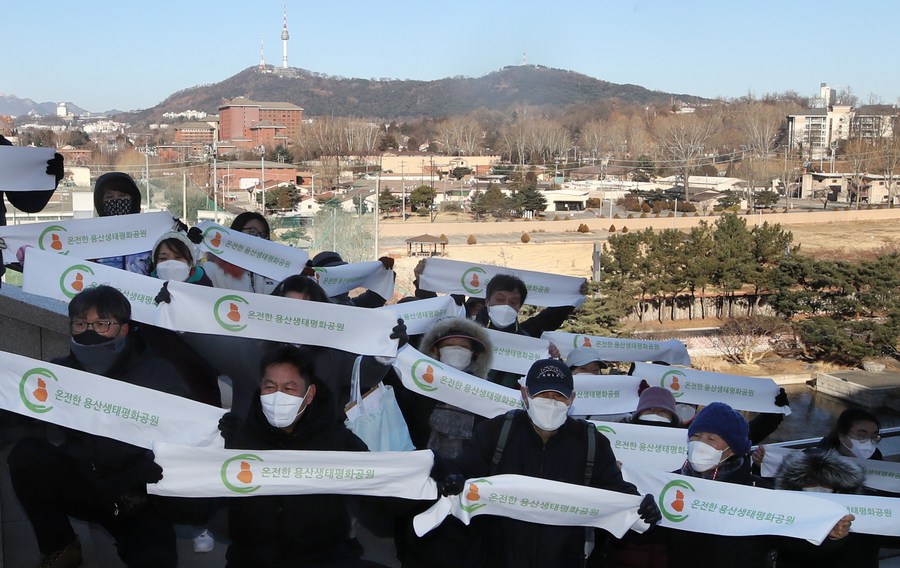
Many South Koreans are frustrated by the lack of data and the inability of the South Koreans to enter bases to perform environmental tests. Throughout most of the U.S., with the notable exceptions of Hawaii and most Army bases, analytical results of PFAS contamination on bases in a host of media are readily available online for the public to see.
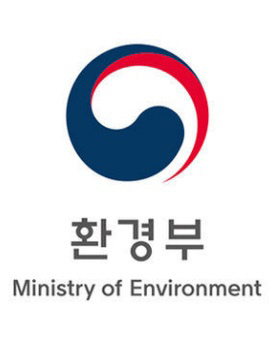
All four branches follow the CERCLA process. CERCLA is the Comprehensive Environmental Response, Compensation, and Liability Act, otherwise known as the Superfund law. South Koreans are also in the dark because the Status of Forces Agreement (SOFA) between the United States and South Korea disallows independent investigations of contamination. South Korea contributes somewhere between 30% and 44% toward the total cost of the U.S. presence.
The South Korean Ministry of the Environment filed its National Implementation Plan for the Stockholm Convention on Persistent Organic Pollutants in 2019. The average concentration of 16 PFAS in seawater at 50 sites (2017) on 36 coastal areas nationwide in ppt was:
Incheon, Asan and Gunsan had the highest levels of PFAS in seawater. PFOS, PFOA, PFHxS, and PFHxA were most prevalent.
Although these numbers do not seem too high, PFOS tends to bioaccumulate in seafood at hundreds to thousands of times the ambient water levels. The chemical is so dangerous that the state of Minnesota limits it to under .05 ppt in some lakes. PFAS levels are generally higher in freshwater rivers than they are in coastal areas by the sea. Generally, independent academic studies have reported much higher levels than the South Korean government.
The United States has yet to ratify the Stockholm Convention on Persistent Organic Pollutants, but participates as an observer in the meetings.
More Surface Water Data
A 2020 study by Young-Min Lee, et al. on PFAS in Asan Bay showed water with a concentration up to 467 ppt. The most prevalent compound was PFPeA, while PFOS was dominant in fish. Camp Humphreys is located on Asan Bay.
High concentrations of PFOS at 651 ppt and PFOA at 62 ppt were reported in a river flowing into Sihwa Lake.
A 2016 study by Nguyen Hoang Lam, et al. collected 65 surface water samples from coastal areas and found total PFAS concentrations up to 73.9 ppt with an average concentration of 22.1 ppt.
PFAS in Fish and Crabs
The European Food Safety Authority (EFSA) says food, especially seafood, accounts for up to 86% of the PFAS in our bodies. Meanwhile, neither the U.S. nor South Korea regulate PFAS in food.

The filet of a Flathead Grey Mullet caught in Busan Bay, not far from the U.S. Busan Naval Base, contained a concentration of 125,030 ppt of PFOS. Meanwhile, South Korea limits drinking water to 70 ppt for PFOS and PFOA. Women who are pregnant or may become pregnant should not be eating this fish and neither should anyone else. Certainly, the blame for poisoning the fish is shared between industry and the military, although fish have been found with nearly 10 million parts per trillion of PFAS in waters near Wurtsmith Air Force Base in the U.S.
PFDoDA, an unheralded, yet dangerous, PFAS compound, was found in the muscle of fish in Busan Bay with these concentrations:
The health impacts of PFOS and PFOA have been widely reported, but PFDoDA is also extremely dangerous because it is associated with liver disease, cardiac defects, gestational diabetes, and eczema. The fish are loaded with a wide variety of these chemicals while almost all the focus by the U.S. military and the South Korean government has been on the drinking water.
A 2018 study by Duc et al. identified 13 separate PFAS compounds in 514 samples of blood, liver, muscle, and egg tissues of ten edible freshwater fish species from major rivers and lakes in Korea.

Highest levels found in blood, liver, eggs, and muscle (ppt)
When we fry whole fish, we are consuming blood, liver, eggs, and muscle (filet). For the sake of demonstrating the potential danger, let’s do a little math. If the fish contained 925,000 ppt of PFOS this would be 46.25 million times the EPA limit for concentrations in drinking water. (925,000/0.02 = 46,250,000)


As we have seen, PFAS in Asan Bay showed water with a concentration up to 467 ppt of total PFAS. With bioaccumulation rates up to thousands of times above levels in the water, it is not surprising to see fish with 197,000 ppt of the carcinogens. We do not know how much of this is the result of military activities at Camp Humphreys, the largest overseas U.S. military installation in the world.
According to a 2020 study by Choi, et al., crabs in South Korea contain high levels of PFAS, while different PFAS compounds are concentrated in their tissues, depending on their habitat. South Korea imports huge quantities of crabs from China, India and Pakistan. Generally, the crabs are not as dangerous as the fish.
Some 19 different PFAS compounds were measured in the edible parts (body, legs, offal and eggs) of crabs originating from South Korea (n = 17), China (n = 14), India (n = 7), and Pakistan (n = 31). The crabs were taken from fish markets in South Korea. All of the crabs were contaminated.
Highest levels of PFAS detected in crabs
PFTrDA is linked to human fetal growth retardation, which brings us to human breast milk.

A 2022 study by Kim, et al., analyzed PFAS in breast milk from 207 “low-risk” Korean mothers. Twelve PFAS compounds were detectable in breast milk samples. PFOS and PFOA were detected in 100% of the samples.
The median concentrations for five compounds in ppt:
The PFAS concentrations in breast milk were higher than those reported in other studies or countries, according to the authors. These concentrations are also greater than the levels allowed by South Korea in drinking water. The study attributes fish consumption to dangerous PFOS concentrations in breast milk. The median concentration of PFOA, arguably the deadliest of all PFAS, was 100 ppt, or 25,000 times the U.S. EPA’s interim health advisory for drinking water.

When PFAS reaches the body through food, water, inhalation, skin, etc., it winds up in the kidneys and other organs. Because the main excretion route of PFAS from the body is from the kidneys, the effect of PFAS on kidney function is crucially important.
A 2023 study of Korean adolescents by the Korean Society of Occupational and Environmental Medicine found PFOA, PFOS, PFHxS, PFNA and PFDeA and their sum were significantly associated with decreased kidney function.
Clinically, the most practical test to assess kidney function is to estimate glomerular filtration rate, (GFR). GFR is the rate in milliliters per minute at which substances in plasma are filtered through the glomerulus, in other words, the clearance of a substance from the blood.
The normal GFR for an adult male is 90 to 120 mL per minute.
Of the total 811 participants, 379 (46.7%) were male and 432 (53.3%) were female. The age of the study participants was 12–17 years, which was relatively evenly distributed.
Do not allow the numbers below from South Korea make your eyes glaze over. Simply put, as the levels of PFAS in blood (ug/L = ppb) increase, kidney function decreases.
There is a lesson here for veterans of military service and others with suspected occupational exposure to PFAS. This is why it is so important to have our blood checked for PFAS levels.

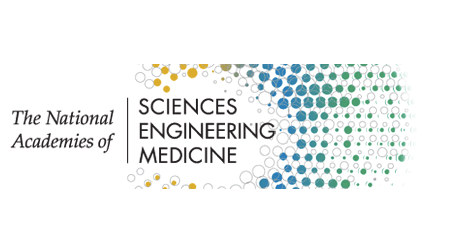
The U.S. National Academies of Sciences, Engineering, and Medicine says there is an increased risk of adverse health effects if the total of seven PFAS compounds exceeds 2 ug/L (MeFOSAA, PFHxS, PFOA, PFDA, PFUnDA, PFOS, and PFNA). 2 ug/L is the same as 2 parts per billion, or 2,000 parts per trillion.
That august scientific association concludes that patients with a serum PFAS concentration of 2 ug/L or higher should be specifically screened for dyslipidemia, hypertensive disorders of pregnancy at all prenatal visits, and breast cancer.
That would be pretty much all of the teenagers in Korea. And the scary thing about all of this is that the older the teenagers in Korea were, the more PFAS they had in their blood, and the more the performance of their kidneys was diminished.
The National Academies says patients with serum PFAS concentration of 20 ug/L or higher, which makes up 25% of the teenagers in Korea, ought to have the following tests performed during all routine visits:

- Conduct thyroid function testing;
- Assess for signs and symptoms of kidney cancer; and
- Assess for signs and symptoms of testicular cancer and ulcerative colitis.
Health professionals worldwide are increasingly calling for PFAS blood screening to examine for immune response, lipid metabolism, thyroid disease, kidney disease, liver disease, diabetes, various cancers, and fetal and child development.
Meanwhile, American military veterans, many with a very high likelihood of occupational exposure to PFAS, are not being screened. Critics say it is because of the astronomical financial liability facing the Department of Veterans Affairs.
“VA does not recommend blood tests to determine levels of PFAS in any individual. This is because most people in the U.S. have measurable amounts of PFAS in their blood and normal ranges have not been established.”

CovertAction Magazine is made possible by subscriptions, orders and donations from readers like you.
Blow the Whistle on U.S. Imperialism
Click the whistle and donate
When you donate to CovertAction Magazine, you are supporting investigative journalism. Your contributions go directly to supporting the development, production, editing, and dissemination of the Magazine.
CovertAction Magazine does not receive corporate or government sponsorship. Yet, we hold a steadfast commitment to providing compensation for writers, editorial and technical support. Your support helps facilitate this compensation as well as increase the caliber of this work.
Please make a donation by clicking on the donate logo above and enter the amount and your credit or debit card information.
CovertAction Institute, Inc. (CAI) is a 501(c)(3) non-profit organization and your gift is tax-deductible for federal income purposes. CAI’s tax-exempt ID number is 87-2461683.
We sincerely thank you for your support.
Disclaimer: The contents of this article are the sole responsibility of the author(s). CovertAction Institute, Inc. (CAI), including its Board of Directors (BD), Editorial Board (EB), Advisory Board (AB), staff, volunteers and its projects (including CovertAction Magazine) are not responsible for any inaccurate or incorrect statement in this article. This article also does not necessarily represent the views the BD, the EB, the AB, staff, volunteers, or any members of its projects.
Differing viewpoints: CAM publishes articles with differing viewpoints in an effort to nurture vibrant debate and thoughtful critical analysis. Feel free to comment on the articles in the comment section and/or send your letters to the Editors, which we will publish in the Letters column.
Copyrighted Material: This web site may contain copyrighted material the use of which has not always been specifically authorized by the copyright owner. As a not-for-profit charitable organization incorporated in the State of New York, we are making such material available in an effort to advance the understanding of humanity’s problems and hopefully to help find solutions for those problems. We believe this constitutes a ‘fair use’ of any such copyrighted material as provided for in section 107 of the US Copyright Law. You can read more about ‘fair use’ and US Copyright Law at the Legal Information Institute of Cornell Law School.
Republishing: CovertAction Magazine (CAM) grants permission to cross-post CAM articles on not-for-profit community internet sites as long as the source is acknowledged together with a hyperlink to the original CovertAction Magazine article. Also, kindly let us know at info@CovertActionMagazine.com. For publication of CAM articles in print or other forms including commercial internet sites, contact: info@CovertActionMagazine.com.
By using this site, you agree to these terms above.
About the Author

Pat Elder is a peace and environmental activist who has run for Congress on the Green Party ticket in Southern Maryland.
He can be reached at: pelder@militarypoisons.org.

